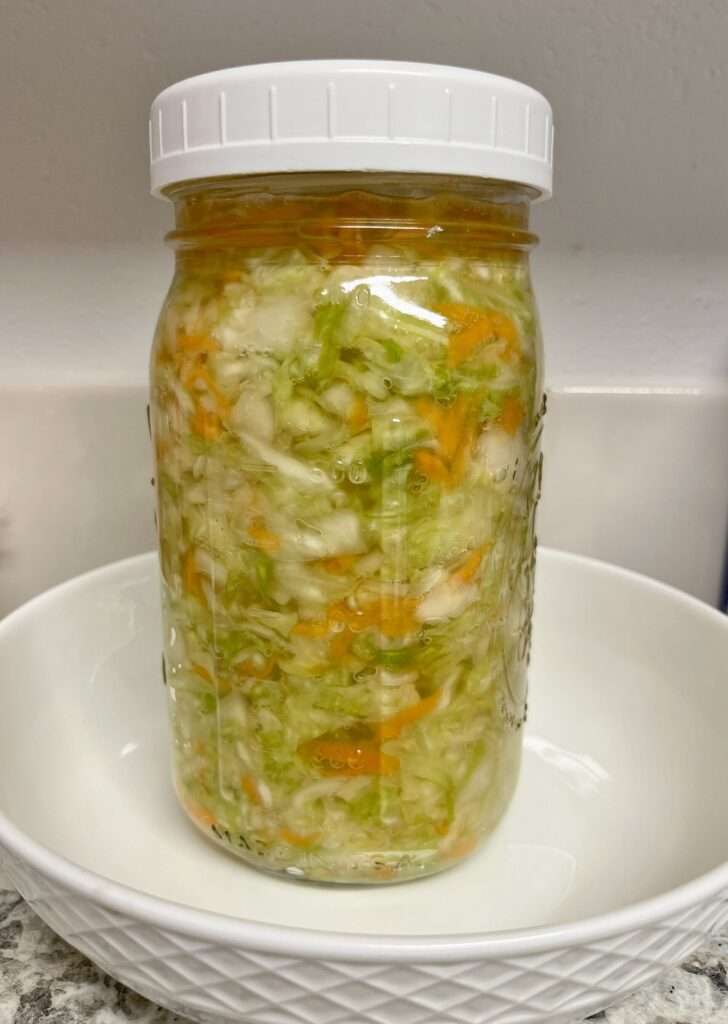Our past generations ate sauerkraut, and for a good reason! It’s easy to make at home, can be a delicious side dish to almost any meal, and very gut healthy. Originating from Eastern Europe, this fermented cabbage dish has a unique tangy flavor and a host of potential health benefits.
Similar post you may like
- Benefits of Sourdough Bread
- Amazing Pine Buds – Natures Powerhouses
- Guilt-Free Dessert -Banana split with a twist!
- Chamomile, Calendula, Spearmint, Elderberry, and Raspberry Leaf Tea Blend

Why you should eat sauerkraut
Probiotic – Sauerkraut is a probiotic-rich food, meaning it contains beneficial bacteria that support a healthy gut microbiome. These bacteria help maintain a balanced digestive system and may improve nutrient absorption.
Improved Digestion – The fermentation process of sauerkraut breaks down the cabbage’s fibers, making it easier to digest. Additionally, the beneficial bacteria in sauerkraut can aid in the digestion of other foods, promoting overall digestive health.
Rich in Vitamins and Minerals – Sauerkraut retains many of the nutrients found in cabbage, including vitamin C, vitamin K, and various minerals. These nutrients contribute to a well-rounded and nutritious diet.
Immune System Support – The probiotics present in sauerkraut have been linked to enhanced immune function. A healthy gut microbiome can help strengthen the immune system and protect against certain illnesses.
Low in Calories and Fat – Sauerkraut is a low-calorie and fat-free food, making it a healthy choice for those watching their weight or following a specific diet.
Versatile Side Dish – Sauerkraut pairs well with a wide range of dishes, from sausages and sandwiches to mashed potatoes and stir-fries.
By incorporating sauerkraut into your meals, you not only add a burst of flavor but also contribute to your overall well-being. So, why not bring back the tradition of enjoying homemade sauerkraut and experience its culinary delights and gut-healthy benefits?
Tools you may need
Ingredients
- 1 large head green organic cabbage (about 2 LB once shredded)
- 3 carrots
- 1 tbsp salt
Ingredients for serving
- onion
- sunflower oil (secret ingredient)
Directions
Prepare the cabbage and carrots
- Prepare the cabbage by removing the outer leaves that are wilted or dirty or damaged.
- Slice the cabbage in half and remove the core from both sides.
- I like to cut the halves in half again.
- Thinly shred the cabbage quarter with a sharp knife or a mandolin slicer. The thinner the better but totally according to your preference.
- Peel the carrots and grate them on the box grater.
Add salt and massage
- Transfer the shredded cabbage and carrots to a large bowl.
- Sprinkle the salt over the cabbage and carrots. Start with 1 tablespoon of salt and adjust according to your taste. For 2 lbs of shredded cabbage and carrots, I added 1 tbsp salt.
- Using clean hands massage and squeeze the cabbage. This helps break down the cell walls and releases its juices. Continue massaging until the cabbage becomes wilted and releases enough liquid to cover it.
Pack the cabbage
- Transfer the salted cabbage and its liquid into your mason jar. Press it down firmly to eliminate air pockets and ensure the cabbage is submerged in its own juices. Leave some headspace at the top to accommodate expansion during fermentation.
- Place the mason jar in a bowl, just in case the brine will spill out. Cover with a plastic lid, but don’t twist it shut. This allows gasses to escape while protecting the sauerkraut from contaminants.
Ferment
- Leave the covered mason jar in the bowl on your counter to ferment
- Every day use a wooden skewer to poke holes all the way down to the bottom, to let the gasses come up.
- Let it ferment 3-5 days on the counter, depending on your desired taste. If you like it more tangy and sour, let it ferment longer. It won’t go back sitting on your counter. Taste it periodically.
Store the Sauerkraut
- Once the sauerkraut has reached your desired flavor, tighten the lid and keep the sauerkraut in the fridge.
- Refrigeration slows down the fermentation process and preserve its freshness. Properly stored sauerkraut can last for several months in the refrigerator.
How to Serve and Enjoy
- My absolute favorite way to serve sauerkraut is getting some in a bowl, adding fresh diced onions, and sunflower oil. You can use any oil but our favorite is sunflower, it adds great flavor.
- Enjoy!
Conclusion
Sauerkraut should be a staple in your home. Make yours today, your family will thank you, your gut will thank you. Grab a jar and some cabbage and get started. It’s easy and very beneficial.


